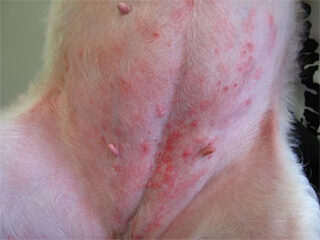 Canine atopic dermatitis (also referred to as allergic dermatitis and canine atopy) is an inherited predisposition to develop allergic symptoms following repeated exposure to some otherwise harmless substance that is inhaled such as dust mites or pollen. Most dogs begin to show their allergic signs between 1 and 3 years of age.
Canine atopic dermatitis (also referred to as allergic dermatitis and canine atopy) is an inherited predisposition to develop allergic symptoms following repeated exposure to some otherwise harmless substance that is inhaled such as dust mites or pollen. Most dogs begin to show their allergic signs between 1 and 3 years of age.
Due to the hereditary nature of the disease, several breeds, including golden retrievers, most terriers, Irish setters, Lhasa apsos, Dalmatians, bulldogs, and Old English sheepdogs are more commonly atopic. However, many dogs, including mixed-breed dogs can have atopic dermatitis. The incidence is increasing both in man and animals.
The hallmark of atopy is pruritus (“itchiness”), defined as an unpleasant sensation that stimulates the need to scratch—whether this is with their claws, teeth, or by rubbing against objects. Atopic animals will usually rub, lick, chew, bite, or scratch at their feet, muzzle, ears, armpits, or groin/anus, causing hair loss, and reddening and thickening of the skin. In some cases, several skin problems can have an additive effect causing these animals to itch where the allergy alone would not be enough to cause itching. These problems include airborne allergens, allergens in food, allergens from parasites such as fleas, bacterial or yeast infections of the skin, and excessive skin drying, which is especially prevalent in the winter months when our homes are being heated. By eliminating some or all of these additional problems, the level of skin irritation may be lowered below the pet’s pruritus threshold, therefore allowing the patient’s itchiness to go away even if one or more of the allergic triggers (antigens) are still present. Therefore, it is important to treat any other problems that could be making your pet itch while dealing with the allergy.
Diagnosis
Specific diagnosis of atopic dermatitis is based upon the results of intradermal testing and/or in-vitro (blood) testing. Many medications can interfere with our ability to properly skin test your pet. The length of time that a medication’s effect remains in an animal’s body is highly variable; however, basic guidelines include withdrawal of oral prednisolone for at least 2 weeks, with longer intervals recommended if your pet has been on prednisolone for a prolonged period or if a more potent glucocorticoid medication was administered.
Treatment
Oclacitinib maleate (Apoquel): This is a synthetic Janus Kinase (JAK) inhibitor, controlling pruritus (itchy skin) associated with allergic dermatitis and control of atopic dermatitis in dogs. As it is not a steroid, side effects like increased hunger and thirst, as well as excessive urination will not occur. It starts working in 4 hours and controls the itch within 24 hours. It can be used with many other drugs and long-term for maintenance therapy.
Allergen-specific immunotherapy: This involves giving an allergy vaccine injection that is made up specifically for your pet, usually for the lifetime of the animal. After an initial series of injecting increasingly potent antigen, boosters will be needed every 2-4 weeks. Usually, 60-80% of animals will improve with the vaccine, with half of those pets having an excellent response, and the other half having a significant response, but which still require ancillary therapy. Results may not be seen for 6 months. When results are not seen in 9-12 months, a re-evaluation is necessary.
Avoidance of the allergens: This can be accomplished by reducing exposure to unfiltered air and reducing the environmental contamination. The use of HEPA filters, frequent replacement of furnace and air conditioner filters, and reducing outdoor exposure for pets with pollen allergies during the time their trigger plant is blooming are helpful, as is washing the pets’ bedding weekly in the hottest water possible. Additionally, wiping down with moist cloths after going outside, and frequent bathing of the pet reduces the pet from carrying around his own supply of offending substances.
Bathing therapy: Bathing can remove antigens from your pet’s coat, and so can be an important ancillary treatment in treating bacterial and yeast infections of the skin. However, it is important to avoid overdrying the pet’s skin in the process, and an emollient skin cleanser (such as Allergroom or Etiderm) and application of a humectant spray (Humilac) or perhaps even a cortisone-containing shampoo (Cortisoothe) or leave-on conditioner (Resicort) are helpful, especially in the winter months.
Antihistamines: This medication works in some atopic patients, though it may take some trial and error usage to determine the best one for your pet. The only side effect is usually drowsiness (especially with diphenhydramine, hydroxyzine, chlorpheniramine and some of the other “older” antihistamines). Some of these are prescription medications, and others are available over the counter.
Fatty acid supplements: Certain types of oils can reduce allergic symptoms in some patients, and they are believed to be synergistic with antihistamines. We can give fish oil capsules in conjunction with a low-fat diet, or prescribe special prescription diets with the fish oil content raised. There are no side effects, though very high doses may impart a fishy odor to the pets breath.
Topical steroids: Mentioned above, these are usually in the form of shampoos, leave-on conditioners, and creams or ointments. Cortisoothe and Resicort are 2 examples. This can be part of a successful program for many pets and can reduce the amount of oral steroids that are necessary, with their concurrent side effects.
Oral steroids: The mainstay is prednisone. It works very well, but has many potential side effects and is reserved for adult animals, those with short seasonal problems or where other therapy is not possible or is ineffective. Typically, treatment is started at one dose, and then tapered off to every other day usage.
Cyclosporine (Atopica or Neoral): This immunosuppressive agent can be used at low doses to treat allergies successfully in about 60% of patients. It can also be used to lower dosages of steroids. The major short-term side effect is gastrointestinal upset. The dosage can often be lowered after a few weeks of successful treatment.
